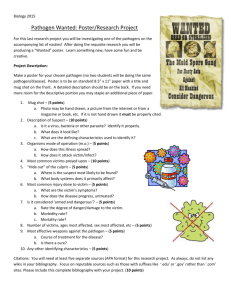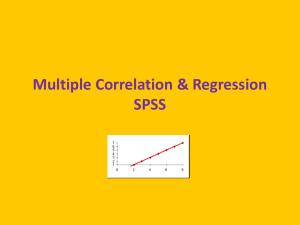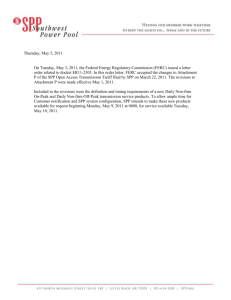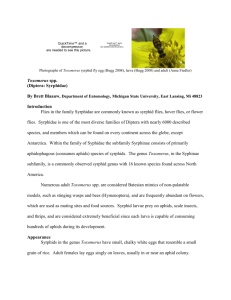Figures and Tables
advertisement
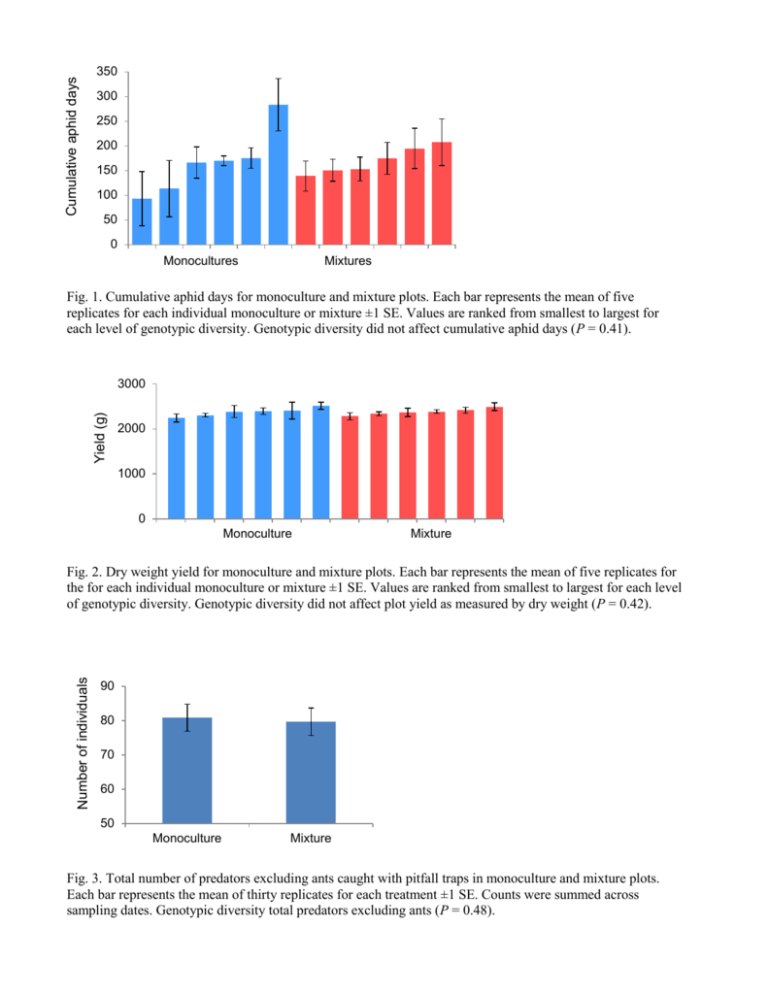
Cumulative aphid days 350 300 250 200 150 100 50 0 Monocultures Mixtures Fig. 1. Cumulative aphid days for monoculture and mixture plots. Each bar represents the mean of five replicates for each individual monoculture or mixture ±1 SE. Values are ranked from smallest to largest for each level of genotypic diversity. Genotypic diversity did not affect cumulative aphid days (P = 0.41). Yield (g) 3000 2000 1000 0 Monoculture Mixture Number of individuals Fig. 2. Dry weight yield for monoculture and mixture plots. Each bar represents the mean of five replicates for the for each individual monoculture or mixture ±1 SE. Values are ranked from smallest to largest for each level of genotypic diversity. Genotypic diversity did not affect plot yield as measured by dry weight (P = 0.42). 90 80 70 60 50 Monoculture Mixture Fig. 3. Total number of predators excluding ants caught with pitfall traps in monoculture and mixture plots. Each bar represents the mean of thirty replicates for each treatment ±1 SE. Counts were summed across sampling dates. Genotypic diversity total predators excluding ants (P = 0.48). Number of individuals 8 6 4 2 0 Monoculture Mixture Fig. 4. Total number of Orius caught with a beat pan in monoculture and mixture plots. Each bar represents the mean of thirty replicates for each treatment ±1 SE. Counts were summed for four samples per plot, taken at the same time. Genotypic diversity did not affect Orius numbers (P = 0.70). Percent reduction in aphid pop. 60 50 40 30 20 10 0 Monocultures Mixtures Fig. 5. Percent reduction of aphid populations for monoculture and mixture pots after exposure to natural enemies in the field. Each bar represents the mean of eighteen replicates for each treatment ±1 SE. Genotypic diversity did not affect the percent reduction in aphid populations (P = 0.42). Cecidomyiid larvae 12 10 8 6 4 2 0 Monocultures Mixtures Fig. 6. Number of cecidomyiid larvae on soybean monoculture and mixture pots. Values represent means for each treatment ±1 SE. Genotypically diverse pots had more cecidomyiid larvae (P = 0.046). Percent time spent on plants 80 60 40 20 0 Monocultures Mixtures Fig. 7. Percentage of time spent by convergent lady beetles on monoculture and mixture pots in a predator choice arena. Treatments were paired within an arena and N=39 for paired comparisons and values are means for each treatment ±1 SE. Of the time spent on the pots, lady beetles spent more time on the mixtures (P = 0.047). Figure. 8. Soybean aphid populations on three soybean growers’ fields in Centre County, PA. Values represent mean counts of aphids/plant on 20 plants/field ±1 SE. Tab. 1. Potential natural enemies caught in pan traps in commercial soybean fields in Centre County, PA. Values are number of individuals for each color of pan trap (blue/yellow) in each grower’s field (grower 1-3) summed across pan traps and across dates. Specimens are adults unless otherwise noted. Blue Order Coleoptera Family Coccinellidae Carabidae Staphylinidae Hemiptera Berytidae Anthocorideae Diptera Dolichopodidae Syrphidae Cecidomyiidae Forficulidae Araneae Opiliones Natural enemy Yellow 1 2 3 1 2 3 Coccinella septempunctata 0 0 0 0 0 0 Harmonia axyridis Propylea quattuordecimpunctata 0 0 0 0 1 2 0 0 0 0 0 3 Lebia viridis 0 0 0 2 0 0 Lebia analis 0 0 0 1 0 0 Staphylinidae 1 7 3 1 3 5 Jalysus spp. 0 0 0 0 0 2 Orius insidiosus 15 19 13 17 27 25 Lygus lineolaris 1 2 0 6 0 1 Dolichopididae 1 2 0 135 14 6 Toxomerus marginatus 0 2 2 1 15 2 Toxomerus germinatus 0 0 0 3 2 1 Sphaerophoria sp. 0 0 0 0 1 0 Cecidomyiidae 0 1 1 0 0 1 Forficula auricularia 0 1 0 0 0 0 Lycosidae Lycosidae 0 0 0 1 0 0 Salticidae Salticidae 1 1 1 0 4 0 Thomisidae Thomisidae 0 2 2 2 0 0 Linyphiidae Linyphiidae 0 4 3 0 0 1 Other small spider 0 0 1 0 1 2 Phalangium spp. 0 0 1 0 0 2 Phalangiidae Tab. 2. Potential natural enemies caught in pitfall traps in commercial soybean fields in Centre County, PA. Values are number of individuals in each grower’s field (grower 1-3) summed across pitfall traps and across dates. UNID=Unidentified. Specimens are adults unless otherwise noted. Order Family Carabidae Coleoptera Staphylinidae Lampyridae Hymenoptera Dermaptera Formicidae Forficulidae 1 2 3 Agonum sp. 1 0 0 Anisodactylus sancaecrucis 22 0 1 Bembidion quadrimaculatum 2 0 12 Cicindella sp. 0 5 0 Chlaenius tricolor 0 4 3 Chlaenius (other) 0 2 0 Clivina sp. 1 0 0 Dicaelus elongatus 0 1 1 Diplocheila sp. 0 2 0 Poecilus chalcites 3 0 1 Poecilus lucublandus 20 0 4 Pterostichus melanarius 0 200 117 Pterostichus (other spp.) 1 0 1 Stenolophus sp. 1 0 0 Carabidae (other adult) 3 0 0 Carabidae (larvae) 3 4 0 Staphylinidae 65 15 31 Lampyridae (larvae) 0 0 2 Coleoptera (larvae other) 3 1 1 Crematogaster spp. 1 0 0 Formica spp. 5 0 1 Lasius spp. 29 1 22 Leptothorax spp. 0 0 1 Myrmica spp. 1 0 2 Ponera spp. 0 1 1 Prenolepis imparis. 9 14 2 Solenopsis molesta 0 5 4 Stenamma sp. 1 16 36 Tetramorium caespitum 1 74 75 Forficula auricularia Allocosa spp. 0 0 1 8 9 0 Hogna spp. 2 0 0 108 106 102 Pirata spp. 0 2 0 Trochosa spp. 24 33 35 Lycosidae (juvenille, UNID) 1 11 0 Linyphiidae Linyphiidae 26 12 19 Oxyopidae Oxyopidae 1 0 0 Philodromidae 0 1 0 Salticidae 0 0 1 Lycosidae Araneae Philodromidae Salticidae Opiliones Natural enemy Phalangaiidae Pardosa spp. Other spider 3 3 8 Phalangium spp. 27 14 313 Centipede (Class: Chilopoda) 15 6 26 Tab. 3. Potential natural enemies caught in pitfall traps in commercial soybean fields in Centre County, PA. Values are number of individuals captured during the day and night in each grower’s field (grower 1-3) summed across sweep samples and across dates. UNID=Unidentified. Specimens are adults unless otherwise noted. Order Family 2 3 1 2 3 Coccinella septempunctata 0 0 2 Coleomegilla maculata 22 2 0 Cycloneda munda 1 0 1 Harmonia axyridis 0 3 1 Hippodamia parenthesis 0 0 1 Propylea quattuordecimpunctata (adult) Propylea quattuordecimpunctata (larvae) Staphylinidae 8 0 13 0 14 0 0 0 8 0 0 0 0 0 1 0 0 0 1 0 4 5 0 0 1 0 0 1 0 2 Cicindella sp. 0 0 0 Colliuris pennsylvanica 0 0 0 Lebia viridis 2 0 0 Lasius spp. 0 0 3 Prenolepis imparis 7 4 12 Tetramorium caespitum 0 2 0 Nabis roseipennis (adult) 16 2 13 Nabis roseipennis (nymph) 0 0 2 Nabis americoferus (adult) 0 2 8 Nabis americoferus (nymph) 4 0 2 103 147 157 Orius insidiosus (nymph) 2 14 12 Podisus sp. 0 2 2 Lygus lineolaris (adult) 20 2 14 Lygus lineolaris (nymph) 10 0 4 Dolichopodidae Dolichopodidae 3 0 1 Cecidomyiidae Cecidomyiidae 2 1 2 Toxomerus marginatus 0 0 1 Toxomerus germinatus 1 0 1 Sphaeorophoria sp. 0 1 0 Chrysopa sp. (adult) 0 0 1 Micromus subanticus (adult) 2 0 0 Micromus posticus (adult) 0 0 0 Hemerobiidae (larvae) 0 0 0 Forficula auricularia 0 1 4 Tetragnathidae 3 0 31 Thomisidae 9 4 4 Pardosa sp. 7 7 4 Lycosidae (juvenille, UNID) 0 6 7 Salticidae Salticidae 3 14 9 Oxyopidae Oxyopidae 6 1 0 Linyphiidae Linyphiidae 3 11 18 3 0 0 0 5 48 1 10 5 0 5 47 5 0 5 5 2 0 1 0 0 0 3 1 1 1 1 6 7 0 2 0 3 2 2 1 0 0 15 1 4 2 0 0 23 1 0 4 2 0 1 13 0 0 0 0 0 0 17 0 9 24 1 3 0 3 0 0 0 0 0 26 0 6 3 3 0 25 0 1 7 2 0 2 0 0 0 0 0 0 0 49 13 4 6 0 2 0 4 Coleoptera Staphylinidae Carabidae Formicidae Nabidae Anthocoridae Pentatomidae Miridae Hemiptera Syrphidae Chrysopidae Hemerobiidae Dermaptera Forficulidae Tetragnathidae Thomisidae Araneae Night Day 1 Coccinellidae Hymenoptera Natural enemy Lycosidae Orius insidiosus (adult) Clubionidae 1 0 0 Philodromidae 0 0 1 Araneidae 1 1 5 Other spider 6 7 12 Phalangiidae Phalangiium spp. 0 1 19 Sclerosomatidae Sclerosomatidae 1 0 0 Clubionidae Philodromidae Araneidae Opiliones 4 0 0 2 3 0 7 0 1 4 2 0 11 3 6 2 23 0





